Hey there, kitchen explorers! Ever wondered why your cooking adventure sometimes leads to a smoky surprise? Gas Stove smoking could be the reason behind it. Well, get ready to uncover the mystery behind your smoky stove and learn how to fix a smoking gas stove at home.

Cooking is like a fun journey, but a smoky stove can make it a little bumpy. Don’t worry, though – we’re here to help you navigate through the smokescreen and make your cooking experience smooth and enjoyable.
Causes of Gas Stove Smoking:
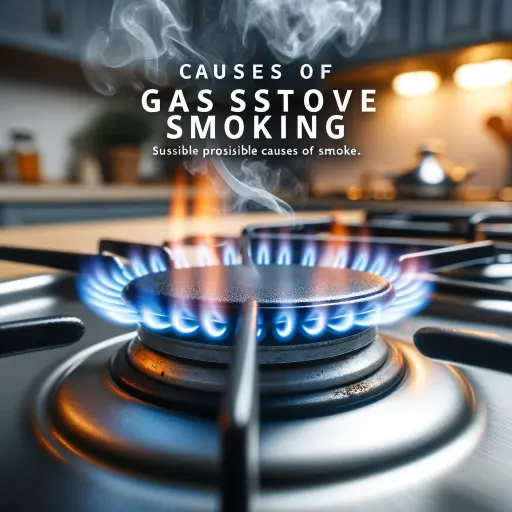
Grease and Grime Build-Up
- Leftover grease and food debris on burners can lead to smoke during cooking.
- Smoke is produced when these residues heat up and create an unpleasant aroma.
Air-Fuel Mismatch
- Incorrect air-fuel mixture in burners can result in incomplete combustion and smoke.
- Too much gas or too little air can lead to the formation of smoke while cooking.
Blocked Burner Openings
- Burner openings clogged with debris or residue can impede proper airflow and cause smoke.
- Smoke is a result of incomplete combustion due to restricted air intake in the burners.
Gas Pressure Quirks
- Irregular gas pressure can lead to uneven flames and smoke during cooking.
- Fluctuations in gas pressure disrupt the proper balance of air and gas required for combustion.
Ignition System
- A malfunctioning or misaligned igniter can cause delayed ignition, resulting in smoke.
- Smoke is produced when the gas doesn’t ignite immediately, leading to incomplete combustion.
Other Potential Causes of Stove Smoking
- Residue Buildup: Accumulated grease, food particles, or spills on burners and grates.
- Improper Ignition: Inadequate ignition or a faulty ignition system.
- Incorrect Burner Placement: Placing cookware on the wrong burner, causing uneven heat distribution.
- Burner Ports Obstructed: Debris blocking the burner ports.
- Uneven Flame Distribution: Uneven gas flow or clogged burner holes.
- Malfunctioning Regulator: Regulator issues can disrupt the gas flow to the stove.
- Gas Pressure Irregularities: Inconsistent gas pressure from the supply line.
- Blocked Ventilation: Inadequate airflow around the stove.
- Improper Pan Covers: Using oversized or mismatched covers on pots and pans.
- Excessive Oil or Fat Splatter: Splattering of oils or fats onto burners during cooking.
- Leaking Gas Lines: A gas leak in the supply lines.
How To Fix a Smoking Gas Stove: Step By Step Guide
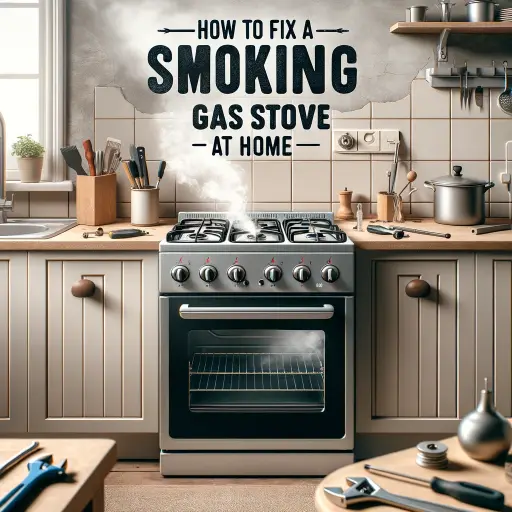
Grease and Grime Build-Up
- Step 1: Mix a gentle dish soap with warm water in a bowl.
- Step 2: Remove the burner grates and caps from your stove.
- Step 3: Dip a soft cloth or sponge into the soapy water and wring it out.
- Step 4: Gently scrub the burners, focusing on areas with visible grease and debris.
- Step 5: For tougher spots, make a paste using baking soda and water, apply it to the stubborn areas, and let it sit for a few minutes before scrubbing.
- Step 6: Rinse the burners thoroughly with clean water and allow them to dry completely.
- Step 7: Once dry, reassemble the burners and caps on your stove.
Air-Fuel Mismatch
- Step 1: Refer to your stove’s manual to locate the air intake adjustment mechanism for each burner.
- Step 2: Turn off the burners and wait for them to cool down completely.
- Step 3: Carefully adjust the air intake by either sliding a shutter or turning a venturi tube. This may involve opening or closing the air passages.
- Step 4: Turn on the burners and observe the flame. Aim for a blue flame with a yellow tip – this indicates a proper air-fuel mixture.
- Step 5: If necessary, fine-tune the adjustments for each burner until you achieve a consistent blue flame.
Blocked Burner Openings
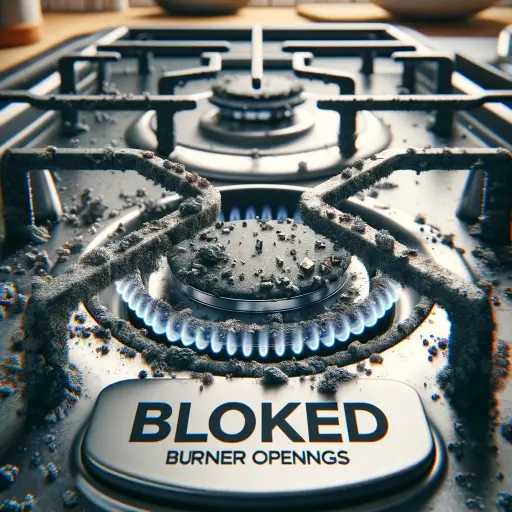
- Step 1: Turn off the gas supply to the stove and allow the burners to cool down.
- Step 2: Remove the burner grates and caps, exposing the burner openings.
- Step 3: Carefully use a needle, toothbrush, or a pointed tool to gently dislodge any debris or residue from the openings.
- Step 4: Use a vacuum cleaner or a can of compressed air to blow away loosened debris from the burner area.
- Step 5: Once the openings are clean, replace the burner caps and grates, ensuring they are properly aligned.
Gas Pressure Quirks
- Step 1: Inspect the gas supply line for any visible leaks, kinks, or damage.
- Step 2: If you suspect a gas leak, turn off the gas supply immediately and contact a professional gas technician for repairs.
- Step 3: If the gas supply line appears intact, consult your gas provider to check for any irregularities in gas pressure.
- Step 4: If needed, a licensed gas technician can adjust the gas pressure regulator to ensure a stable and consistent flow of gas to the stove.
Ignition System
- Step 1: Turn off the gas supply to the stove and let it cool down.
- Step 2: Locate the igniter near the burner that is producing smoke.
- Step 3: Gently clean the igniter’s surface with a soft cloth to remove any dirt or residue that might be hindering ignition.
- Step 4: Ensure the igniter is properly aligned with the burner, allowing for a direct spark.
- Step 5: Turn on the burner and observe if the ignition is prompt and smooth. If not, consider replacing the igniter according to the manufacturer’s instructions.
Solution for Other Potential Causes
- Residue Buildup: Regularly clean burners, grates, and the surrounding area with a non-abrasive cleaner.
- Improper Ignition: Ensure burners ignite properly; clean or replace faulty igniters.
- Incorrect Burner Placement: Use appropriately sized burners for your cookware to avoid uneven heating.
- Burner Ports Obstructed: Gently clean burner ports using a soft brush or a needle.
- Uneven Flame Distribution: Adjust the air shutter or clean clogged burner holes to ensure even flames.
- Malfunctioning Regulator: Consult a professional to inspect and replace the faulty regulator if needed.
- Gas Pressure Irregularities: Contact your gas provider to check and adjust gas pressure if necessary.
- Blocked Ventilation: Ensure proper ventilation by keeping vents clear and allowing fresh air circulation.
- Improper Pan Covers: Use appropriately sized covers to prevent excess smoke and improve cooking efficiency.
- Excessive Oil or Fat Splatter: Use a splatter guard or be mindful when cooking to prevent excessive splatter.
- Leaking Gas Lines: If you suspect a gas leak, immediately turn off the gas supply and contact a professional technician for repairs.
Remember, if you encounter persistent smoking issues, it’s advisable to seek professional assistance to ensure the safety of your appliance and your home.
Can Spill Trays Reduce Stove Smoking
Spill trays, which are designed to catch spills and drips on a gas stove, may indirectly help reduce smoking from the stove, but their primary purpose is to prevent spills from reaching the internal components of the stove and to make cleaning easier.
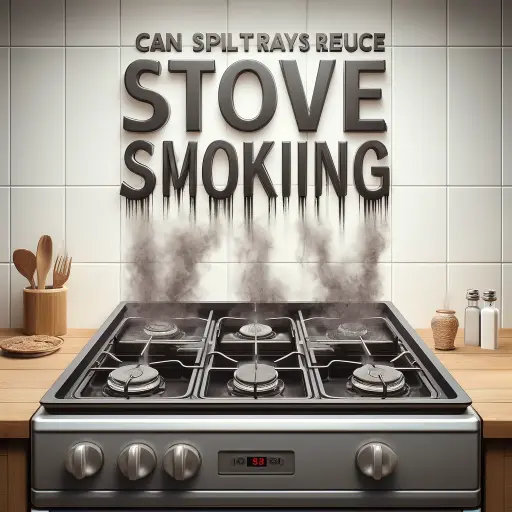
Smoking from a gas stove can occur due to several factors, and while spill trays can play a role in managing some of these factors, they may not eliminate smoking entirely. Here’s how spill trays can be related to reducing smoking:
- Preventing Grease Buildup: One common cause of smoking from a gas stove is the accumulation of grease and food residue on burners, grates, and other components. Spill trays can help by catching grease and food spills, preventing them from building up on the burners. This can reduce the likelihood of grease catching fire and producing smoke.
- Minimizing Drippings: Drippings from cooking, especially when they fall directly onto the burner flames or hot surfaces, can lead to smoking. Spill trays can catch these drippings, reducing the chances of them causing smoke when they come into contact with heat.
- Easier Cleaning: Spill trays are easier to clean than the internal components of a gas stove. Keeping the trays clean can help maintain optimal stove performance and reduce the chances of smoking caused by residue buildup.
While spill trays can contribute to a cleaner and potentially less smoky cooking experience, it’s important to note that they may not address all potential causes of smoking from a gas stove. Other factors, such as the type of cookware used, the quality of gas combustion, and the presence of ventilation, can also influence smoke production.
To further reduce smoking from a gas stove, consider these additional tips:
- Ensure proper ventilation in your kitchen to expel any smoke or fumes.
- Use cookware with lids to contain smoke and reduce splattering.
- Clean and maintain your gas burners and grates regularly to prevent residue buildup.
- Avoid cooking with excessive heat, as this can lead to more smoke production.
- If you suspect an issue with your gas stove’s combustion or gas supply, consult a professional technician for inspection and maintenance.
In summary, spill trays can contribute to reducing smoking from a gas stove by preventing spills and grease buildup, but they are just one part of a comprehensive approach to minimizing smoke in the kitchen. Proper maintenance, ventilation, and cooking techniques are also essential factors to consider.
Can Electric Stove Produce Smoke
Electric stoves, known for their clean and efficient cooking, generally do not produce smoke as part of their normal operation. However, there are instances where an electric stove can generate smoke.
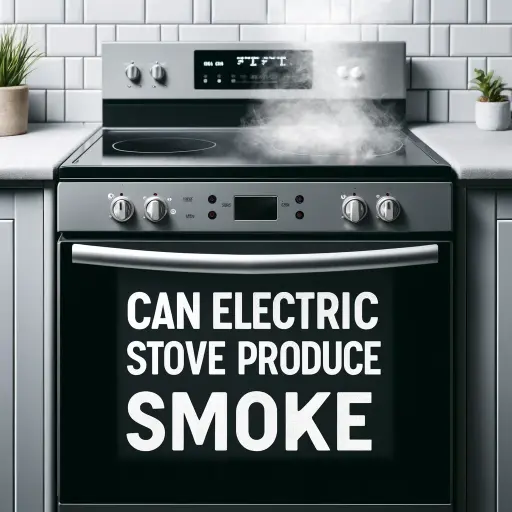
This usually happens when food or other materials come into direct contact with the hot burner element. It’s crucial to be mindful of this potential for smoke production, as it can occur if proper care isn’t taken during cooking.
Unlike gas stoves, which may produce smoke due to spills or incomplete combustion, electric stoves operate differently. They rely on the heating element to transfer heat directly to the cookware.
This means that any smoke produced is usually a result of something touching the hot surface. This can be easily prevented by keeping the stovetop clean and ensuring that no materials are left on the burners.
While electric stoves are generally considered cleaner in terms of air quality since they don’t directly burn fuel, it’s important to note that they are not entirely smoke-free. Careful maintenance and regular cleaning of the heating elements can help minimize any potential for smoke production.
By following these simple precautions, you can enjoy the benefits of cooking on an electric stove without worrying about excessive smoke.
Comparison
| Aspect | Gas Stove | Electric Stove |
|---|---|---|
| Smoke Production | Can produce smoke if spills or residue present | Rarely produces smoke unless material contacts burner |
| Ventilation | Proper ventilation is crucial for safety | Ventilation important for steam, odors, and accidental smoke |
| Rarely produces smoke unless material contacts the burner | Incomplete combustion can produce harmful gases | Does not directly produce combustion byproducts |
FAQs
How do I stop my stove burner from smoking?
To stop stove burner smoke, clean burners regularly to remove grease and debris, ensure proper air-fuel mixture, and check for any obstructions in burner openings.
Why is my gas burner bringing out smoke?
A gas burner may produce smoke due to grease buildup, imbalanced air-fuel mixture, blocked openings, or malfunctioning components.
Why is my gas stove giving black smoke?
Black smoke from a gas stove indicates incomplete combustion, often caused by poor air-fuel balance, clogged burner openings, or irregular gas supply.
Why is my stove smoking after cleaning?
Smoke after cleaning can occur if residue wasn’t thoroughly removed. Ensure burners are completely dry and free of debris after cleaning to prevent smoke
Can gas pressure affect stove smoke?
Yes, irregular gas pressure can disrupt the proper balance of air and gas, leading to incomplete combustion and smoke production on your gas stove.
Conclusion
We have covered in detail how to fix a smoking gas stove remember that your gas stove is like a cooking partner – it needs a little care and attention to perform its best.
By keeping it clean, adjusting its dance of gas and air, and making sure nothing’s blocking its path, you can bid farewell to those smoky surprises.
Cooking should be a joyful experience, and a smoke-free stove makes it even better. So, armed with these simple solutions, you’re ready to cook up a storm without any unwanted smoke stealing the spotlight.
SOURCES
Up in Smoke: The Influence of Household Behavior on the Long-Run Impact of Improved Cooking Stoves
